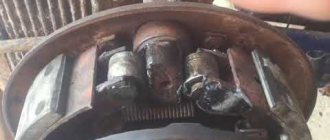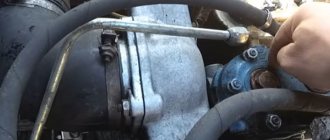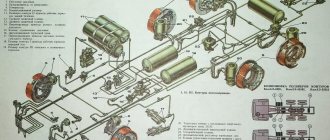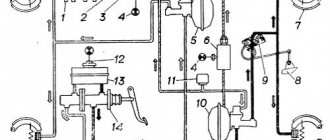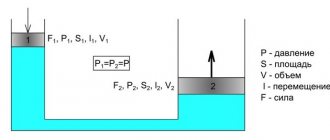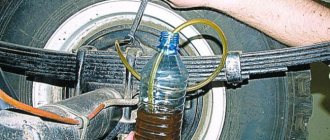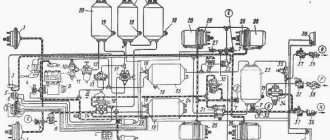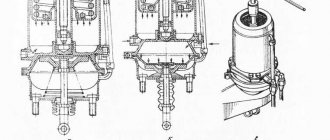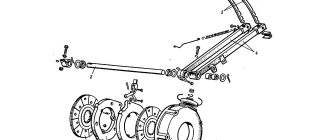6.1.1. Brake systems. Device. Pneumatic brake actuator
Schematic diagrams of the pneumatic brake drive of the MAZ-64227 and MAZ-54322 vehicles are shown in Fig. 95 and 96. The supply part of the pneumatic brake drive consists of a compressor 1 (see Fig. 95), a moisture separator 2, a pressure regulator 3, a condensation receiver 4, a double protective valve 5 and the pipelines and fittings connecting them. When the engine is running, compressed air from the compressor enters through the moisture separator 2, the pressure regulator 3 into the condensation receiver 4 and then through the double protective valve 5 into the receivers 8 and 9. At the same time, the compressed air from the compressor through the single protective valve 7 enters the receiver 10, to which the additional consumers: auxiliary brake mechanism drive, clutch booster, etc. When the pressure in the system reaches 8 kgf/cm², the pressure regulator is activated, and further air flow into the system is stopped - the compressor is unloaded into the atmosphere. Simultaneously with the pressure regulator, the moisture separator operates, releasing the condensate accumulated in it into the atmosphere. The pneumatic brake drive includes the following independent pneumatic circuits: · brake mechanisms of the front axle wheels; · brake mechanisms of rear and middle axle wheels; · parking (spare) brake mechanism; · semi-trailer brake mechanisms; · auxiliary brake mechanism and other consumers of compressed air. All pressure-reducing receivers are equipped with condensate drain valves 30. In addition, the pneumatic system includes pneumoelectric sensors 27, connected to the corresponding lamps on the instrument panel, which turn on when the pressure in a particular circuit decreases below 5.6 kgf/cm², as well as sensors 29, associated with pressure gauges installed on the instrument panel. The pneumatic drive of the service brakes works as follows. When you press the brake pedal, the brake valve 18 is activated. Compressed air from the receiver 8 through the lower section of the valve enters the brake chambers 22, which activate the brake mechanisms of the front axle wheels. From the upper section of the brake valve, through the brake force regulator 20, air is supplied to the control line of the accelerator valve 19, as a result of which the latter passes compressed air from the receivers 9 into the brake chambers of the wheels of the rear and middle axles. At the same time, through the two-line valve 23, air enters the control line of the accelerator valve 19a, which passes compressed air from the receiver into the cavities of the energy accumulators 21, eliminating the possible double impact on the wheel brake mechanisms (from the working and parking systems). The brake valve, brake force regulator and accelerator valve have a follower device, that is, compressed air enters the brake chambers, the pressure of which depends on the amount of movement of the brake pedal. In addition, the brake force regulator takes into account the load on the rear suspension and, depending on it, passes a certain pressure into the control cavity of the accelerator valve 19. When the rear suspension is fully loaded, the brake chambers receive full pressure, determined by the brake valve 18. When releasing the brakes, air from the front brakes chambers, the brake force regulator and the control cavity of the accelerator valve 19 exits into the atmosphere through the brake valve, and from the rear brake chambers through the accelerator valve 19a. During braking, compressed air from the drive lines of the front and rear brake mechanisms enters the brake control valve 15 of a semi-trailer with a two-wire drive, as a result of which the valve is activated, and the air from receivers 8 and 9 through single safety valves 7 and check valve 14 enters the semi-trailer line . When a tractor is coupled to a semi-trailer with a single-line brake drive, compressed air flows through the brake control valve 16 of a semi-trailer with a single-line drive and the connecting head to the air distributor of the semi-trailer and into its air receiver. When braking, air is released from the connecting line through valve 16 and the semi-trailer is braked. When coupling a tractor with a semi-trailer with a two-wire brake drive, connecting heads 25 of the power and control lines are used. The pneumatic drive of the parking and emergency brakes operates as follows. Compressed air from receivers 8 and 9 through single safety valves 7 and check valve 14 is supplied to parking brake control valve 17, from which it enters the control line of accelerator valve 19a through a two-line valve 28, as a result of which the latter passes compressed air from receivers 8 and 9 into the cylinders of the energy accumulators of the brake chambers 21. When braking with the parking brake (the valve handle 17 is installed in the rear fixed position), air from the control line of the accelerator valve 19a escapes into the atmosphere. In this case, the air from the cylinders of the energy accumulators of the brake chambers 21 escapes into the atmosphere through the atmospheric outlet of the accelerator valve. The springs, unclamping, activate the brake mechanisms of the rear axle. At the same time, valve 17 turns on valve 15 for controlling the brakes of a semi-trailer with a two-wire drive, thereby ensuring braking of the semi-trailer. In the event of an emergency drop in pressure in the parking brake drive circuit, the spring energy accumulators are activated and the vehicle is braked. In this case, to release the car, it is necessary to unscrew bolts 8 (see Fig. 92) on all brake chambers 21 (see Fig. 95). The parking brake control valve has a tracking device that allows you to slow down the vehicle (by the backup brake system) with an intensity depending on the position of the valve handle. The pneumatic drive of the auxiliary brake system operates as follows. When you press the auxiliary brake control valve 11, compressed air enters the brake control pneumatic cylinder 13. The cylinder rod, connected to the auxiliary brake flap lever, turns the flap, and it closes the exhaust pipe of the muffler. At the same time, compressed air enters cylinder 12, the rod of which moves the engine stop bracket, thereby stopping the fuel supply. The units and equipment of the pneumatic brake drive are discussed in the following sections.
How to remove a brake drum
During vehicle operation, both the brake pad linings and the inner surface of the drum wear out. As a result, braking efficiency is lost. In this case, it is necessary to dismantle the drum and replace the pads. The dismantling work is not difficult, but it will require some physical effort, because... the parts are heavy.
To remove the brake drum, do the following:
- install the machine on a flat surface and secure it against possible movement;
- jack up the wheel;
- unscrew the nuts and remove it;
- screw 3 M10 bolts into the holes on the drum cover and press it out;
- remove the part from the hub.
It must be remembered that the TB is made of cast iron, so you need to use a hammer to remove it with great care.
Symptoms of a problem
The fact that the handbrake has stopped working can be understood by the following characteristic signs.
- After setting the parking brake, the wheels do not lock and the vehicle is not securely secured.
- Setting the parking brake requires a lot of effort.
- The knot, on the contrary, is too easy to influence.
One of these signs may indicate that there is a problem with the parking brake. However, in the case of VAZ cars, the handbrake may not work the first time even if there are no problems. An unreliable fixation of the car after the third attempt to tighten the cables can be considered a sign of a handbrake malfunction.
Frequent causes of breakdowns
As a rule, the answer to the question of why the handbrake does not work lies in the most banal things. There are 4 main parking brake faults.
- An incorrectly adjusted bolt that needs to be loosened or tightened.
- Braided cable wedge. In this case, the handbrake breaks down due to moisture getting inside, which leads to corrosion.
- Broken cables running from the bar to the wheels. This element is easy to replace.
- Cable souring. This happens if you do not use the parking brake for a long time.
In addition, the reason why the handbrake breaks sometimes lies in the condition of the brake pads. They can wear out, which is why a characteristic grinding noise is heard when the car stops. In this case, it is necessary to replace worn parts, which, as a rule, fail on the right and left wheels at the same time. Incorrect use of the handbrake itself can also lead to this. It must be completely lowered while driving.
Another reason why the handbrake does not work well is the appearance of deposits on the brake pads. This happens rarely, most often after driving around puddles. Ice, salts and chemicals can be removed by lightly pressing the brakes while driving the vehicle for short distances. In addition, the linings may simply be oily due to a leak in the oil seal or working cylinder. In this case, you must first eliminate the fault in the leaking element, and then completely replace the pads or clean them.
Repair of KAMAZ handbrake crane video
KAMAZ handbrake brake valve
Why KamAZ slowly puts on the handbrake
Repair of brake valve KAMAZ ZIL PAZ MAZ KRAZ GAZ
Air leak from the brake valve KAMAZ ZIL PAZ MAZ KRAZ GAZ
Handbrake valve for 6520 3 holes 9617231110 ZTD
Brakes jam on KAMAZ ZIL GAZ PAZ LAZ MAZ. Brake valve repair.
We install the KAMAZ accelerator on Foton 1093
KAMAZ accelerator valve
Everyday life of Kamazist: Elimination of air leaks, repairs
handbrake from Kamaz, on Oka
- Filter for KAMAZ Kamenz
- Power steering KAMAZ 6460
- Injection pump sensor bosch KAMAZ euro 3
- Filming a KAMAZ engine video
- Baltika KAMAZ view
- Accident involving a motorcycle and a KAMAZ
- ASR sensor on KAMAZ
- Test drive military KAMAZ video
- Chain for KAMAZ concrete mixer
- Getting to know the KAMAZ vehicle
- Selection of tires for KAMAZ
- View tractors and KAMAZ trucks
- Loading capacity of a KAMAZ dump truck with a trailer
- Engine from KAMAZ stove
- Just us and KAMAZ
Home » Clips » Repair of the KAMAZ handbrake crane video kamaz136.ru
How the handbrake works
Before we talk about why the parking brake does not work, it is worth understanding the general principle of its operation. It is quite simple, so understanding how the handbrake works is not difficult.
The hand or parking brake looks like a special handle in the interior. It is located next to the driver's seat. Sometimes the parking brake can also be a foot brake. When the lever is lifted, the internal cable, coupled to the bar by means of an adjusting bolt, is tensioned. At the edges of the bar there are two more cables that go towards the rear wheels. When they are tensioned, the brackets inside the drums are unclenched and the pads are moved apart. This is how the wheels are locked.
How to check the operation of the MAZ brake pedal position sensor?
To test the system you need to do the following:
- Test the entire assembly with a multimeter;
- Disassemble the part and inspect all its components;
- Replace the MAZ sensor with a new part.
The dialing process consists of alternately measuring the contacts of the device.
Contacts are checked in pairs and separately. During a visual inspection of components after disassembly, broken springs, oxidation and contamination of the contact plate are most often detected.
In the latter case, for normal operation of the sensor, it is enough to clean the plate. Excessive contact mobility is often detected.
Malfunctions and adjustment of the MAZ pedal sensor
Signs of a breakdown of the MAZ brake pedal position sensor are:
- The corresponding error appears on the panel;
- A noticeable decrease in the responsiveness of the power plant;
- A short-term increase in engine speed when the gears are engaged.
To adjust the MAZ pedal sensor, you need to screw in the part before the pedal begins to lower.
Then the mechanism is slightly unscrewed and secured with a nut. The normal position is one in which, when the pedal is not pressed, the sensor rod is recessed into the body, and when applied, the pedal is released completely.
The working gap is adjusted using nuts: the top one is screwed in and the bottom one is unscrewed.
It is very important to keep the stroke clearance within 2-5 mm. When starting to work with automotive electrics, you should remove the negative terminal from the battery.
Selecting a MAZ brake pedal position sensor is simple. However, if you do not know which sensor to buy, call a specialist from our store. We will advise you on your choice, organize delivery and offer competitive prices for spare parts for MAZ trucks.
The so-called handbrake is an important component in a car, ensuring safety when the driver is not in the cabin. The parking brake locks the vehicle's wheels, preventing it from moving unintentionally. This is especially important if the car is parked on a slope. The need to put the car on the handbrake is indicated not only by common sense, but also by traffic regulations.
KAMAZ parking brake valve operating principle
KAMAZ handbrake brake valve
KAMAZ brake system
KAMAZ accelerator valve
We install the KAMAZ accelerator on Foton 1093
Handbrake valve for 6520 3 holes 9617231110 ZTD
Repair of handbrake KamAZ 55102
Air leak from the brake valve KAMAZ ZIL PAZ MAZ KRAZ GAZ
Pneumatic braking system
Double-circuit safety valve KAMAZ
KamAZ trailer air distributor
- 6460 KAMAZ cummins
- Construction of KAMAZ brake drums
- Body heating KAMAZ 6520 euro 4
- Steering cardan KAMAZ Euro
- Heat exchanger sensor KAMAZ Euro
- KAMAZ wheels 53215 euro
- Engine repair KAMAZ 5320
- King pin plug KAMAZ
- KAMAZ thermostat response temperature
- Replacing the oil seal in a fuel KAMAZ
- Oil leak between gearbox and KAMAZ engine
- How to drive a KAMAZ 4350
- High pressure hose for KAMAZ power steering
- Fun 1 KAMAZ
- Calipers for KAMAZ 5308
Home » Selections » KAMAZ parking brake valve operating principle kamaz136.ru
